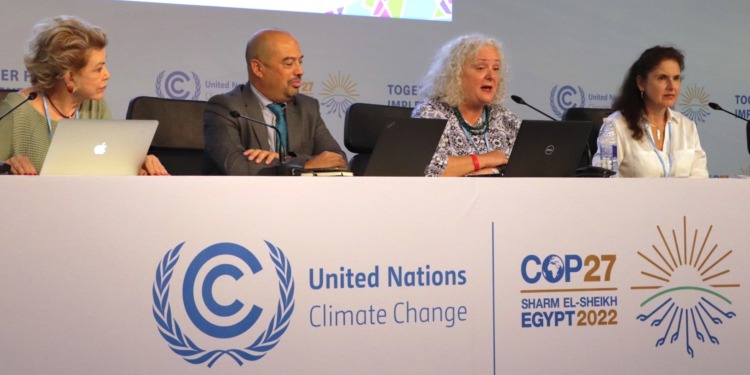After a turbulent year since COP26, characterised by war and global financial instability, the 27th session of the Conference of the Parties (COP27) to the UNFCCC began today in Sharm El-Sheikh, Egypt. The conference will finish on 18 November.
COP27, nicknamed both the “African COP” and the “Implementation COP”, is meant to ensure full delivery of the Paris Agreement in its second phase, which kicked-off with the adoption of the Glasgow Climate Pact at COP26.
Collaboration between nations will be one key focus of this COP, but so will cooperation between municipal, regional, and national governments. The role of regional and municipal governments in the fight to keep “keep 1.5°C alive” was given official acknowledgement for the first time at COP 26.
Home of subnationals in the @COP27p Blue Zone: https://t.co/rU2KjB3oHe
Building on last year success, #LGMA's Multilevel Action Pavilion will continue to make national discussions locally relevant with daily updates, 70+ events, 25+ partners & the motto #MultilevelActionDelivers pic.twitter.com/TmWUMniirg
— ICLEI (@ICLEI) October 27, 2022
That is what is at the heart of the Local Governments and Municipal Authorities (LGMA) Constituency. At COP 27, LGMA will allow sub-national government entities to be given a greater role in negotiating the next steps after the Glasgow Climate Pact.
First day of COP27: A reminder of what it is all about
In his welcome statement, COP27 president Abdel Fattah El-Sisi stated that this COP “aims to be the moment when the world moved from negotiation to implementation and where words were translated to actions.”
The key areas of focus for this COP will be:
- Mitigation – The effort to reduce human-induced climate change, with a continued focus on minimising the global average temperature to ‘well below’ 2°C, and ideally 1.5°C, above pre-industrial levels;
- Adaptation – A global effort to increase our ability to adapt to climate change and build our capacity to resist and rebound;
- Finance – How to decarbonise economies and provide adequate funding for developing nations in their climate efforts;
- Collaboration – How to increase global cooperation in the face of a crisis that is affecting the poor and the rich parts of the world differently.
This – in the area of global collaboration – is where networks of local and regional governments and cities will have a field day, finally in a position to move the needle. This could prove to be a game-changer given the absence of several key players that had been active in the past. For example, both China and India have recently tended to downplay the climate issue, in favour of playing along with Putin, buying cheap oil and gas from Russia.
Who are LGMA and what is multilevel action?
The LGMA represents networks of local and regional governments under the United Nations Framework Convention on Climate Change (UNFCCC). They have acted as the voice of cities and regions since being designated an official United Nations constituency group at the 1992 UN Earth Summit and advocated for local governments at the first climate Conference of Parties (COP) in 1995.
Multilevel action refers to the delegation of action throughout the different levels of government. LGMA advocates for the idea that, within the context of the climate, “multilevel” action is more effective than relying on national action.
When a city or region is given the ability to take charge of its approach to the climate crisis, the results can be more effective since they have been tailored to the unique situation of one area, rather than a whole nation.
The LGMA Multilevel Action Pavilion will be the home of cities and regions throughout COP27.
Located in the Blue Zone, it will act as an “online and in-person pavilion where the national discussions and decisions will be made locally relevant under the motto #MultilevelActionDelivers.”
Over the course of the next two weeks, the Multilevel Action Pavilion will host over 70 events with partners including ICLEI – Local Governments for Sustainability, Scottish Government, Marrakech Partnership, Africa Partners, and CC35.
ICLEI, a global network of cities, regions and towns committed to sustainability, acts as the LGMA Focal Point and the official “convener” of the partners to the LGMA. ICLEI members stretch across the globe and include the COP26 host city of Glasgow.
Impakter will be providing coverage from the pavilion throughout COP27 as a partner of ICLEI.
The Cities and Regions Pavilion: Agenda, Themes & Desired Outcomes
Throughout COP27, the Multilevel Action Pavilion will be where the outcomes of the conference are translated to the level of the region and the city. Here, a network of sub-national authorities and governments will formulate responsive action.
Yunus Arikan, Director of Global Advocacy at ICLEI, said in the Multilevel Action Pavilion’s opening press conference on Sunday:
“LGMA calls on UNFCCC Parties to acknowledge that multilevel action delivers the Paris Agreement, building on the recognition of the multilevel and cooperative action in the Glasgow Climate Pact and the transformative power of sustainable urbanisation to respond to climate emergency.”
Related Articles: COP: What Is it Exactly and Why Is COP27 so Important? | Solar Energy at COP27: What to Expect
Beyond this broad function, LGMA have set out a four-point advocacy agenda for COP27: enhanced NDCs through multilevel action, addressing unfinished business, welcoming the first Climate & Urbanization Ministerial, and empowering Africa and the MENA Region.
The COP27 Presidency, in collaboration with UN-Habitat and ICLEI, have also developed the Sustainable Urban Resilience for the next Generation (SURGe) Initiative, “a multilevel climate governance initiative sponsored by the COP27 Presidency and endorsed by 70+ organizations that seeks to achieve sustainable and resilient urban systems by focusing on five tracks: buildings and housing, urban energy, urban waste/consumption, urban mobility, and urban water.”
LGMA hopes to see a global endorsement of this initiative in the next two weeks.
At the LGMA press conference on Sunday, a panel of representatives introduced the constituency’s agenda for COP27 and focussed on the need for finance. One unresolved issue from COP26 was the inability of the developed world to fulfil promises of funding for developing countries.
Now, LGMA is calling for cities and regions to receive the appropriate loans and grants necessary to achieve any goals set out for the second phase of the Paris Agreement.
Apostolos Tzitzikostas, the President of the European Committee of the Regions and Governor of the Region of Central Macedonia in Greece, summed up the goals of regions and cities at COP27:
“Local and regional governments deliver 70% of climate mitigation, and 90% of climate adaptation, yet still do not have a formal seat in the UN climate negotiations, nor were their views properly represented by the EU in Glasgow. This is legally, financially and democratically wrong. Without ownership, citizens living in regions, cities and villages cannot be expected to support such an over bureaucratic top-down process. The COP26 lacks not only ambition in climate targets, but realism in governance. It now falls to the world’s sub-national governments to unite and make up for the national government failings”.
LGMA success at past COPs
The LGMA saw its greatest success at COP26 in Glasgow and there is well-grounded hope now that this trend of success will continue at COP27.
The main goal of the constituency since being established is to increase representation of local governments within global negotiations concerning climate action. For years, it has raised awareness of the importance of the sub-national level of government in constructing and implementing successful actions to mitigate and adapt to the changing climate.
At COP26, LGMA urged the world to embrace multilevel action—collaboration across all levels of government—as an essential element to respond to the climate emergency and achieved significant success.
The preamble of the Paris Agreement now recognises that all levels of government are instrumental to securing the 1.5°C limit goal. The Glasgow Climate Pact enshrined “multilevel collaboration” as a new normal for how the Paris Agreement can be implemented, and references to multilevel action appear more than 30 times in the outcome documents.
In the spirit of the “Implementation COP”, hopes are high among LGMA and its partners that what has been largely lip-service from the Paris Agreement so far will finally be translated into concrete action over the next two weeks.
Editor’s Note: The opinions expressed here by the authors are their own, not those of Impakter.com — In the Featured Photo: ICLEI announcing LGMA Cities and Regions Pavilion inputs to COP27 through #MultilevelActionDelivers. Featured Photo Credit: Screenshot from the live stream of the press conference.










